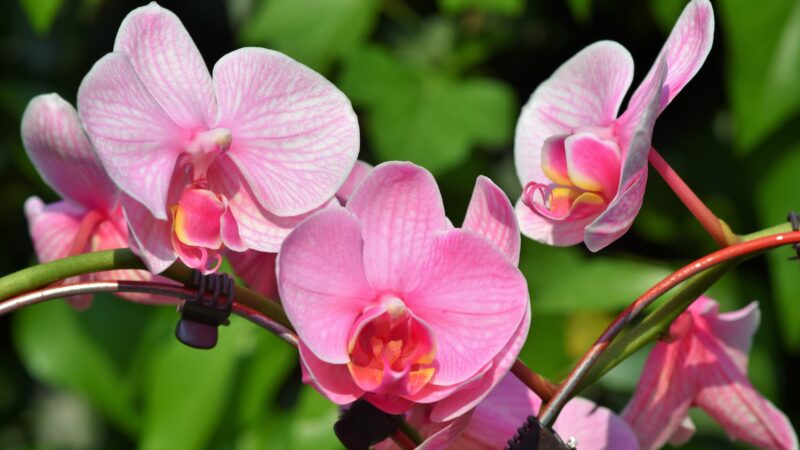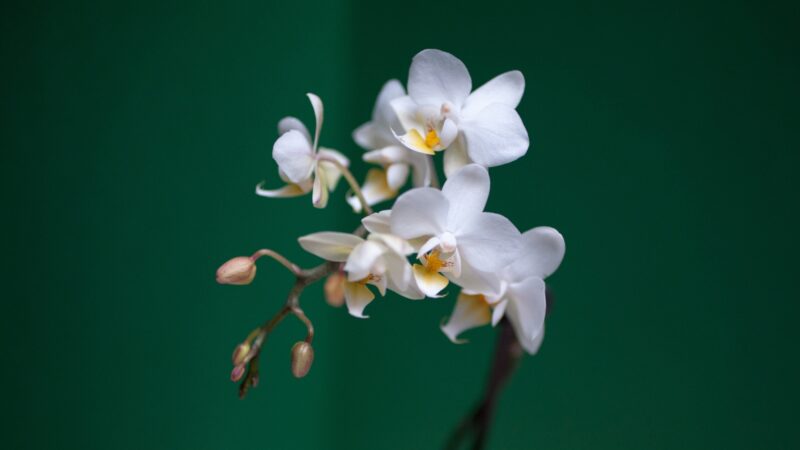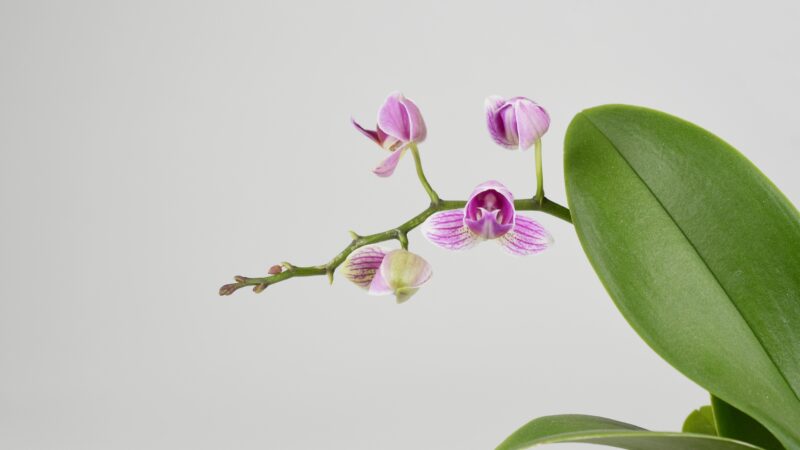Orchids are popular houseplants, whether they are placed indoors or outdoors. This is due to their colorful flowers, linear bloom clusters, and sweet fragrance.
They’re also quite easy to care for. But like all plants, orchid flowers fall off within ten weeks after they bloom – it’s simply part of its natural cycle.
Orchids are capable of reblooming after their flowers have fallen off naturally. As long as it is continuously given proper care, enough water, and adequate sunlight, your orchid will continue to grow and bloom naturally.
However, in most cases, it can be quite tricky to make your orchid rebloom for the first time. But once your orchid has successfully rebloomed, the succeeding ones will be easy.
Fortunately for you, this article will guide you to successfully rebloom your orchid. Read on to learn more about the tips and tricks on how to rebloom your orchid.
Do Orchids Rebloom?

Orchids do rebloom. They simply go through a cycle that involves the blooming of their flowers, they’re falling off, a dormant hibernation period, and the blooming cycle begins.
Orchids start growing their spikes during the late fall or winter, which become ready for blooming once springtime ends. Then, the flowers stay on the plant for around ten weeks before they start to fall off naturally.
After the orchid loses all of its flowers, it merely goes into a hibernation stage. Thus, you should not discard your orchid simply because it lost its flowers. Simply take care of it until the end of its hibernation stage – usually when it starts growing its flowering spikes again.
When Do Orchids Rebloom?

Orchids start flowering by the end of spring or the start of summer. However, their bloom spikes usually start growing once the temperatures drop, and that commences sometime between the late fall and early winter seasons.
How Often Do Orchids Rebloom?
Orchids rebloom once a year. To make sure your orchids stay healthy and produce beautiful flowers, it has to go through their hibernation phase. That’s why orchids only bloom once every year.
How Long Does It Take for an Orchid to Rebloom?
As earlier discussed, orchids rebloom once every year. This includes a dormancy or hibernation period that lasts for about six to nine months. During this stage, your orchid may look green and healthy – the only difference being the fact that it does not have any flowers.
During this hibernation stage, orchids replenish their bodies with nutrients to prepare for another blooming season. This is because orchids tend to use up a lot of energy whenever their flowers start blooming.
Why Won’t My Orchid Rebloom?

Light
One of the reasons why orchids won’t rebloom is that it does not get the right amount of light needed. Orchids are among the plants that need indirect sunlight to bloom and grow into healthy plants.
When it’s not getting enough sunlight, it will not produce enough energy from photosynthesis. As a result, it might fail to bloom. In contrast, when it gets too much sunlight – especially if it is exposed directly under the sun – it might burn its leaves and bloom spikes. This also fails to rebloom.
Roots
Another reason why orchids won’t rebloom is if there is a problem with their root system. Bear in mind that roots are responsible for absorbing the nutrients from the soil. If it is not functioning at its best, then the plant will not have enough nutrients to produce new flowering buds.
Damage to the roots usually happens due to overwatering. When an orchid is overwatered or when the soil is not well-draining, the roots become soaked. This results in soggy roots – and sometimes, this can even lead to root rot.
There are also instances when the roots become damaged because it wasn’t carefully handled when it was transferred between pots. That’s why it’s necessary to make sure to handle your orchids carefully during their regular repotting.
Water
Like all plants, orchids need water to survive. When it is dehydrated, it won’t just prevent the production of flower spikes and buds, but it will also result in its eventual wilting and death.
In contrast, giving your orchid too much water will result in its mushy leaves and droopy appearance. If your orchid already has buds available, overwatering it may prevent these buds from blooming. It may even cause these buds to fall off instead.
Thus, giving it too much or too little water will prevent it from blooming.
Season
Orchids have a cycle that corresponds to the temperature changes every season. After the first bloom, they go through a hibernation period to replenish the energy they consume from flowering. After a few months of hibernation, they will be ready to grow new bloom spikes which the flowers will emerge from.
The drop in the temperature once autumn arrives usually start the spikes’ growth process. This only happens once a year, so you cannot expect another bloom within the same year.
Natural Stimuli
Another reason why orchids do not bloom is that it does not receive the natural stimuli that signal when their bloom spikes may start growing. Orchids rely largely on the temperature to determine what’s going on around them.
As earlier discussed, orchids start to grow bloom spikes once the temperatures drop. When the temperatures do not go below 60 degrees Fahrenheit for extended periods, it may not get the signal that it’s time to grow spikes. And that fails the orchid to bloom.
How to Get Orchids to Rebloom?
Cutting the Flower Spike
One of the best ways to ensure that your orchids rebloom is to cut the flowering spike. By cutting off the old flower spike, your orchid focuses its energy on healing it and thereby encourages it to produce a new bud.
As a rule when it comes to cutting off the flower spike, only trim about an inch of it. However, if the tip of the spike already looks wilting or rotting, then you may cut off the portion that is already damaged.
You may also trim more than an inch if the flower spike seems to be creeping too long for your liking. But in all instances, make sure to use garden shears like these Handheld Pruners that are easy to grip – and make sure that they are sterilized.
- 【Make Pruning Work Easier】Rust-resistant stainless steel...
- 【User-friendly Safety Lock】These garden shears have locking...
- 【Garden Gloves for Hand Protection】One size fits most. This...
- 【Widely used】This gardening shears set comes with 3 different...
- 【After Sales Service】 Reliable Customer Support. Please feel...
Feed Your Orchid
Feeding your orchid with fertilizer will also help it rebloom. Specifically, a fertilizer that has a high phosphorus content will boost the chances of it blooming during its season. This is because phosphorus is a mineral that provides plants with the nutrients it needs to ensure bud development and growth.
A good option to consider is the Sun Bulb Better Gro Orchid Plus Bloom Booster Fertilizer, which is specifically formulated to boost the growth of bloom spikes. However, make sure not to overfeed your orchid with fertilizer since this may burn its roots.
Find the Best Location Spot
Like all other plants, you have to find the best location where your orchids will grow at their best. Specifically, it has to be placed where the warm temperature stays constant, where the air is quite humid, and where it will be exposed to indirect light for up to eight hours.
If the orchid is placed where the environmental conditions seem to change a lot, this may stress out your orchid. And that will surely prevent it from reblooming. Thus, the key is to make sure that you place your orchid in a spot that’s conducive to its growth.
Give a Chance to a Young Orchid to Grow
If you bought a young orchid, there’s a chance that it has not reached maturity. That means that it will not yet develop its bloom spikes for another two to four years.
With that in mind, it’s best to simply take care of your young orchid during this growth period. Be patient with it and in time, it will bloom beautiful flowers once it reaches maturity.
Learning Orchid Growth Cycle
To ensure that your orchids rebloom, you must familiarize yourself with its growth cycle. This will allow you to determine when the blooming period starts so you can adjust to your orchid’s needs accordingly.
When it comes to the orchid’s growth cycle, the key is to determine the best season for growing bloom spikes. Orchid spikes tend to grow once the temperatures drop, specifically in the late fall or early winter.
Once the temperatures start to rise again during the springtime, these spikes have developed buds that will blossom into flowers once it’s summertime.
Limit Orchid Variety
There are instances when orchids tend to bloom better when they are surrounded by other orchids. However, you have to remember that not all orchids have the same blooming schedule – so make sure to limit the orchid variety you have to those that share the same schedule.
To give you an idea, orchids that bloom at the same time are the Cooktown orchid, the moth orchid, and the venus slipper. In contrast, cattleyas are known for their ability to bloom in different seasons.
Thus, it may be best to plant cattleyas alone, while other orchids with the same blooming schedule may be planted together.
Protecting the Buds
Another tip that you should remember is to protect the buds. At this stage, you have successfully grown the bloom spikes. These, in turn, have already grown buds. However, you must note that having these buds is not an assurance that they will bloom.
That’s why it’s important to make sure you don’t stress out the buds. The key here is to make sure the environment where you place the orchid is stable – this means no abrupt changes in temperature, humidity, and lighting. During this stage, make sure to give your orchids enough water to make sure it’s well-hydrated.
Recovery Time Between Flowering
Earlier, it has been discussed that orchids have a hibernation period once all the flowers have fallen off. This hibernation period also serves as the orchid’s recovery period.
During this period, the orchid replenishes its lost energy and nutrients to bloom again the following year. Usually, the recovery time is around six to nine months.
With that in mind, you shouldn’t rush your orchid into reblooming. Just be patient and give it the best care while you wait.
Repot When Needed
All plants need to be repotted once they outgrow their old pots, and orchids are no exception. This allows its roots to grow and spread into the soil to make sure it grows into a healthy plant.
However, only repot your orchid once a year or every two years. Repotting very often can stress out your orchid, and that will prevent it from reblooming.
As a rule, you will know when it’s time to repot when the roots tend to break free from the pot.
Right Temperature
Orchids are tropical plants. As such, they thrive when the temperature is warm. Specifically, they prefer temperatures ranging between 65 to 75 degrees Fahrenheit for blooming their flowers.
But before the flowers bloom, they prefer temperatures lower than 60 degrees Fahrenheit for growing their bloom spikes and buds.
Sufficient Humidity
Aside from the temperature, another factor to consider is humidity. Orchids prefer a high-humidity environment to breathe. Specifically, the moisture content in the air should be around 40 to 70%.
When the humidity levels drop below this threshold, the air becomes too dry. Unfortunately, the stomata on the orchids tend to close when the air becomes too dry. Since the stomata are the part of the plant that allows it to breathe, this will be as if you are suffocating your orchids.
Thus, by making sure that your orchids are in a high-humidity environment, they are sure to bloom at the right time.
Sufficient Light
Sunlight helps plants with their photosynthesis – and orchids are no exception. While orchids tend to dry up under direct sunlight, they will thrive under indirect sunlight.
Thus, it’s best to position your orchids somewhere where they can get indirect or filtered sunlight for six to eight hours. A spot by the window with curtains or a screen door will work best.
Sufficient Water
Orchids do not need a lot of water to survive. They only need about three ice cubes worth of water every week. Make sure that you do not give it more or less of this amount – otherwise, you’ll find yourself with an orchid that’s either dehydrated or overwatered.
List of Sources
Orchids – https://hgic.clemson.edu/factsheet/orchids/
Orchids as Houseplants – https://extension.psu.edu/orchids-as-houseplants
Growing Orchids at Home – https://extension.tennessee.edu/publications/Documents/PB1634.pdf

